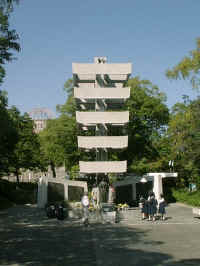 Page 1 2 3 4 5 6 7 8 9 10 11 12 13 14 15 16 Friday, 25 October. We awoke to another mild and sunny day. After having the hotel's big buffet breakfast, we explored the huge lobby atrium with its fountain and wide spiral ramp, very popular for weddings. At 10:00 we took a taxi to the Peace Memorial Park and Museum, built on part of the land leveled in 1945 by the first atomic bombing. We spent two hours touring the museum first. It tells the story of the effects of the A-bomb on Hiroshima and its people, putting a personal face on the city's 140,000 casualties. (Many more died later from the effects of the radiation.) It contains many items of clothing and equipment showing the effects of the blast, but focused almost exclusively on children. There is not a single exhibit showing damage to military personnel or equipment, even though there is a sign acknowledging that the city had a very large concentration of military facilities. In spite of this somewhat slanted approach, the museum provides a very moving experience, and few could leave it without feeling a revulsion toward nuclear war. We met Tom in the museum's snack bar, then walked the length of the Peace Park. It was crowded with Japanese visitors, mostly young students. In the center of the park is an arch-like cenotaph for the A-bomb victims. Behind that is a rectangular pool, then the Flame of Peace. Continuing on in a straight line, across the Motoyasu River is the A-Bomb Dome, the shell of a concrete building left after the blast.
Before the river, slightly off to one side, we saw the Children's Peace Monument, flanked by displays of thousands of origami cranes folded by children. The cranes have become a symbol of the Peace Park because of Sadako Sasaki. She was two-years old when exposed to the A-bomb's radiation. She showed no ill effects until ten years later when she developed leukemia. She had heard that if she folded a thousand paper cranes her wish (to be cured) would come true. She folded far more than that, but died nevertheless a few months later.
We took a taxi to the train station where we had lunch. We caught the 2:38 Hickari train to Kyoto. This time, alerted by Tom, we watched out the train window for two castles we would pass. The first was Fukuyama Castle, right next to that city's train station. It was originally built in 1622, but reconstructed in 1966 after being destroyed by U.S. bombs. A few stops further on we saw Himeji Castle (1601) on a hill just behind the city. This castle tower is one of the dozen surviving originals. It is also one of the four castles designated a National Treasure. We changed to the local train in Kyoto and were back at Tom's about 5:15.
Copyright © 2000-2023 DarrellPeck.com All rights
reserved. | |||










